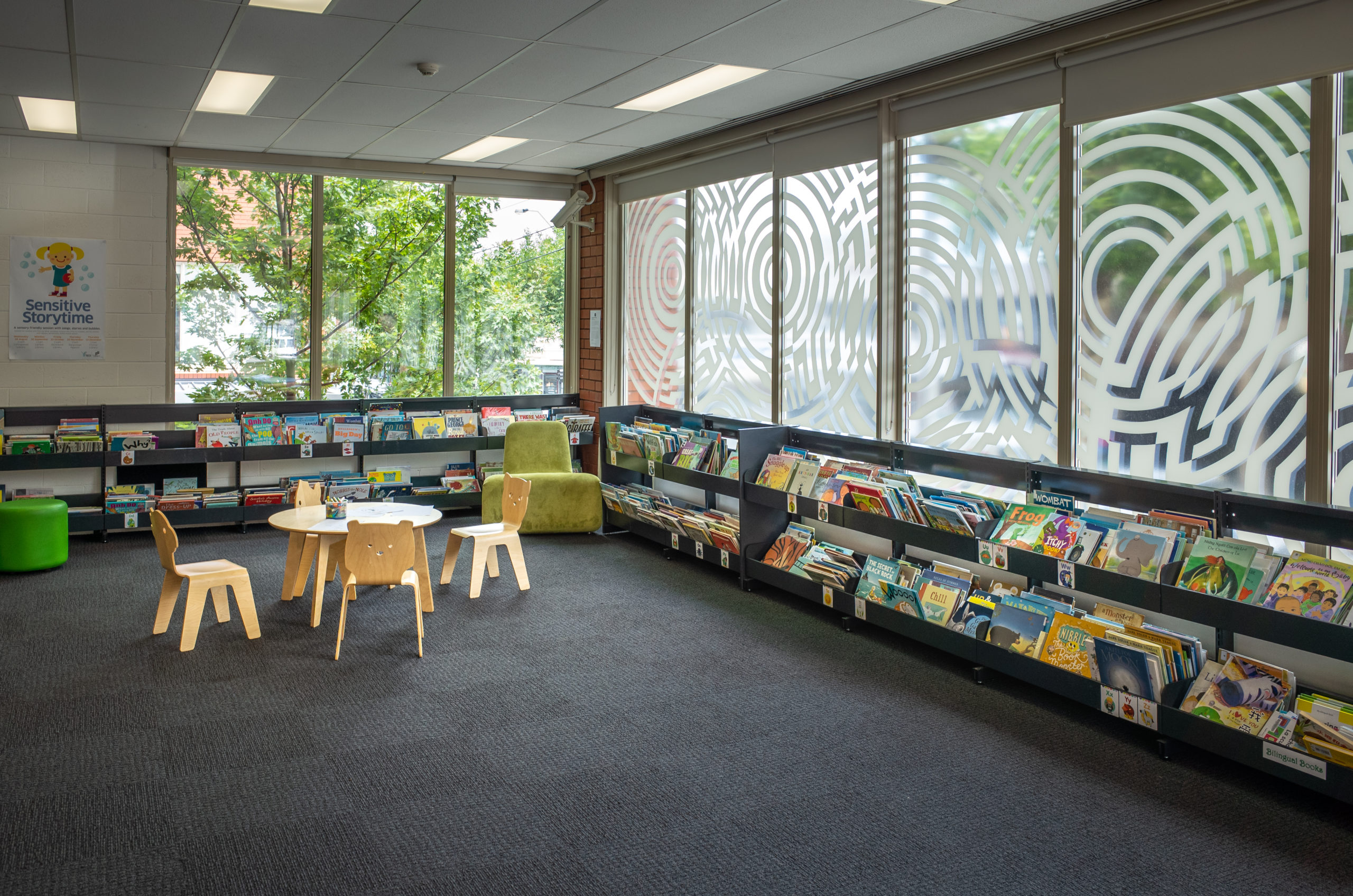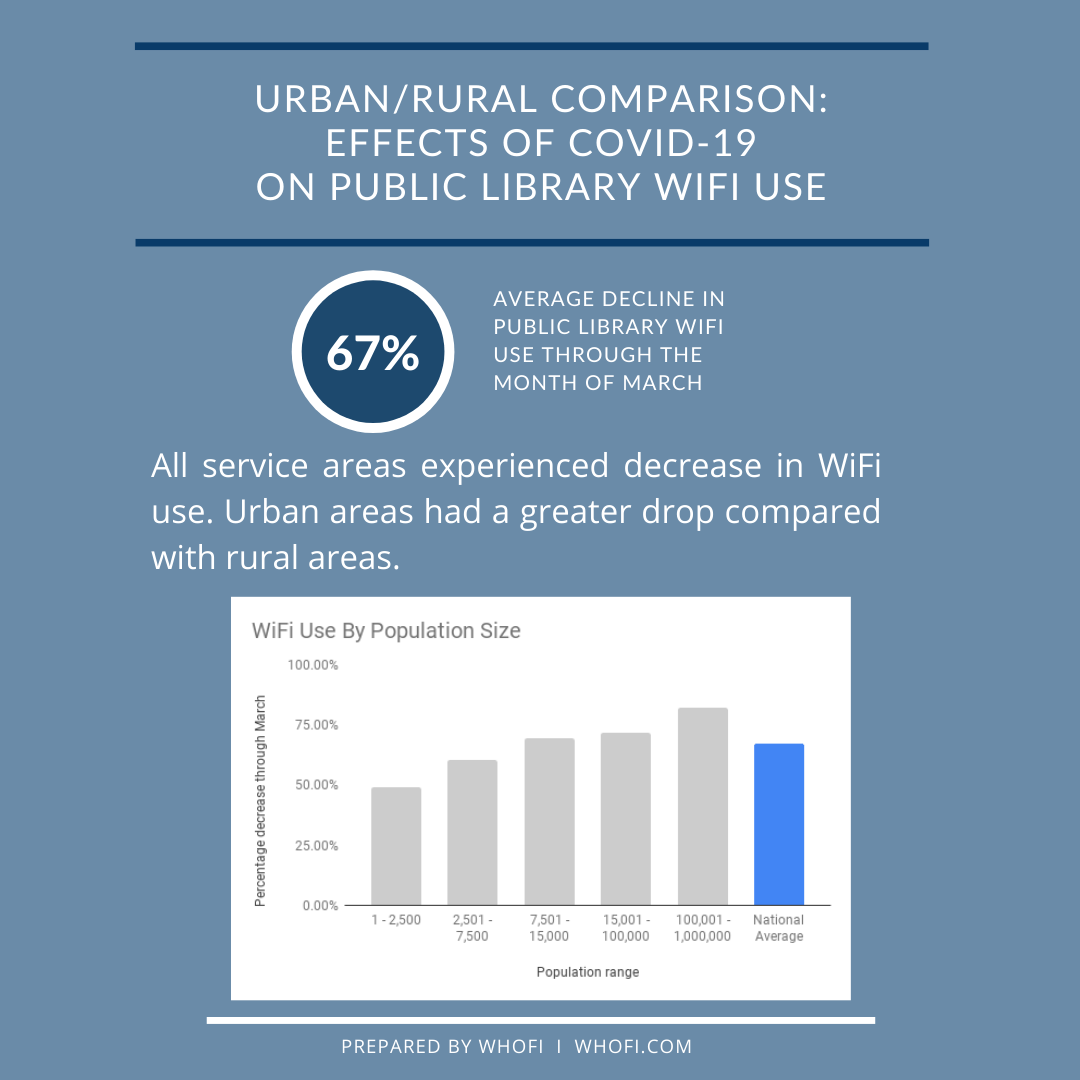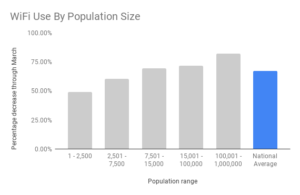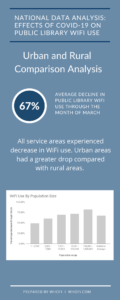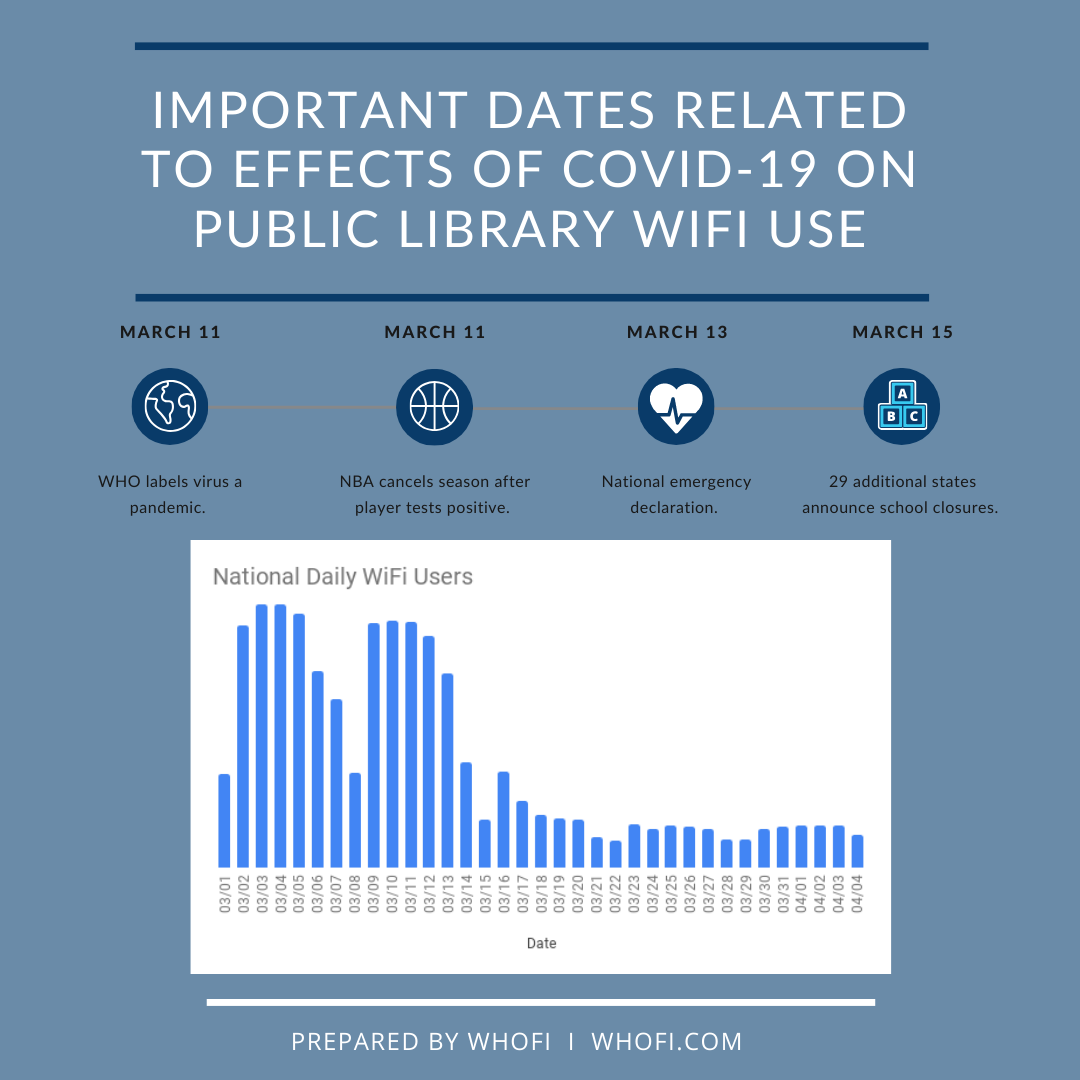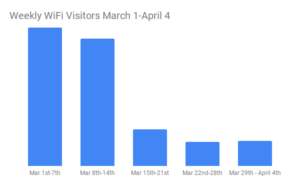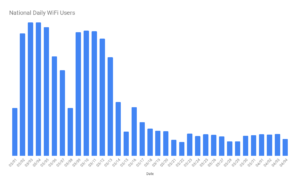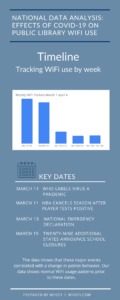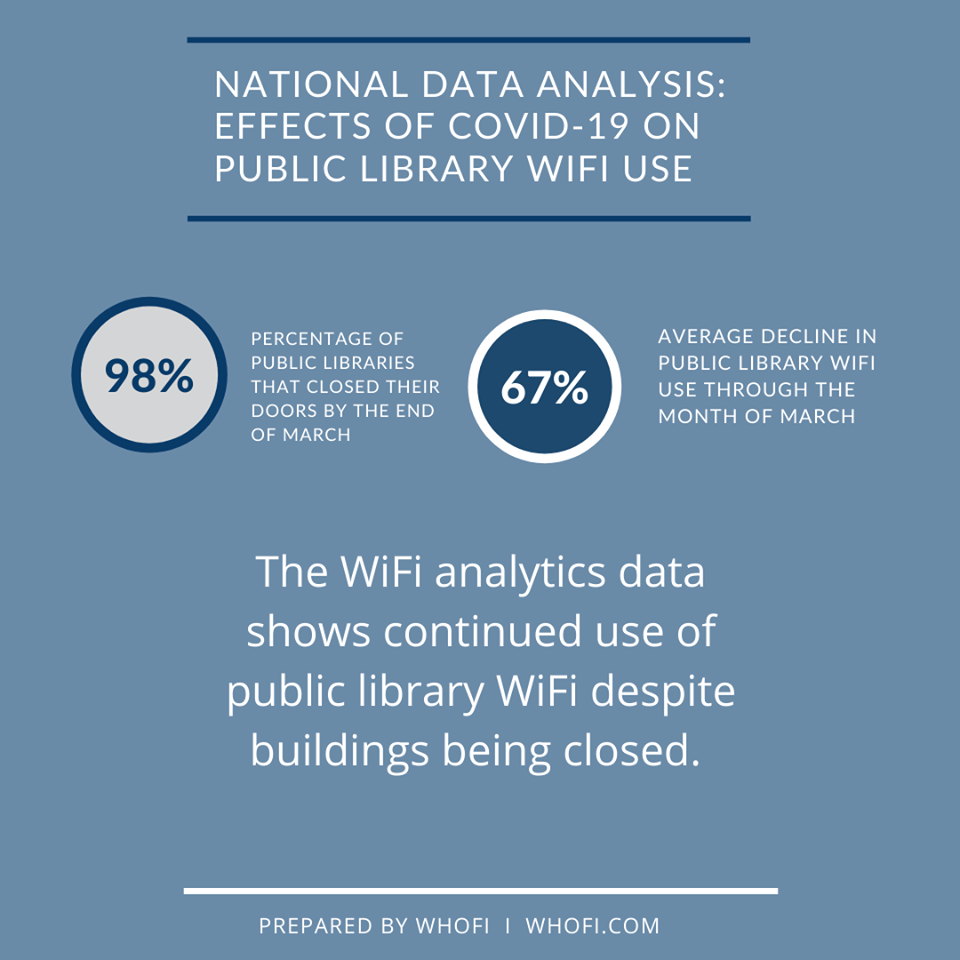Navigating The Next Phase of COVID-19 Library Service
It’s now officially summer, and we’re approaching nearly three months since statewide shutdowns were in place. The impact on daily life certainly has been jarring. For many families and individuals, the public library is a mainstay in our lives. Visiting our local library was part of a regular routine. While nothing can replace the real-world library experience, libraries have done an excellent job adapting to continue to serve communities. Creative ideas keep communities connected–like offering “drive-in WiFi”, expanding digital access, moving adult and children’s programming to an online format, and offering all kinds of digital resources. Now, libraries begin to navigate into the next phase of COVID-19 library services.
As some states ease the shelter-in-place restrictions and businesses re-open (with social distancing guidelines in place) what does this mean for libraries and the communities they serve?
The library is a summertime staple for many families who come for the children’s programming, storytime, kid’s events, or just a safe place to play on a hot day. And, public libraries are an important support system for individuals experiencing unemployment or homelessness, which has skyrocketed since the COVID-19 outbreak. Free WiFi and access to computers and other services help patrons apply for benefits and seek employment.
There are certainly many things for libraries to consider when re-opening and navigate the next phase of COVID-19 library services. This will look different for every library depending on the severity of the virus’s local impact on that location and specifics about each library and community. The library’s role in the community is just as important, arguably more, as it was pre-pandemic. But the way in which it functions within this new environment will change. We hope that insight gained from WiFi analytics can guide the direction.
The Effects of COVID-19 on Public Library WiFi
The WhoFi team released a series of blogs outlining the effects of COVID-19 on public library WiFi use. We analyzed data from our library partners to understand the effects and to determine how, or if, the spread of COVID-19 affected public library WiFi usage and patron behavior. We found that patron use of library WiFi did decline, but this is expected when a building closes. The interesting thing is that WiFi analytics is showing the continued use of library public WiFi despite the closure. This is in part due to the library’s efforts to continue and expand services. It also highlights the library’s essential role within the community and the value of extended COVID-19 library services. Libraries can use data to assess patron behavior amid COVID-19 and determine how to best help them and advocate for themselves.
Here are the highlights of what we learned:
- There was a correlation between key events related to COVID-19 and decreased WiFi use which provides an interesting insight into patrons’ behavior.
- Patron WiFi use did decrease, but only by 67% at the end of March.
- Even after the ALA officially recommended closing libraries to the public, patrons were accessing the WiFi which both illustrates the value of this service and the community need.
- Our data shows that library WiFi use in both urban and rural populations showed a decrease, but urban areas had a much greater drop, perhaps reinforcing the reality of the digital divide.
- The data shows continued use of the library WiFi which validates the importance of this service.
Libraries can use WiFi insights to learn how patrons are feeling as we move into the next phase of COVID-19 library services.
These insights can provide answers to questions like: Are patrons continuing to use drive-in WiFi and at what rates? How does patron visit time compare to pre-pandemic visit times? Are there new users and how many? Are returning visitors coming back at the same rate as before? Are we continuing to meet the WiFi needs of our community? After a few months of insight gathering, what is our new normal benchmark? These are just some of the questions that can be answered by using WiFi insights.
One thing remains true, the community needs its library, and the library needs its community.
Libraries can use WiFi insights to make data-influenced decisions. They can guide protocol on how to best serve the community as we enter into summer and whatever lies ahead. We don’t know when things will be back to pre-COVID life. But one thing is for sure, our libraries will continue to adapt to the ever-changing reality and provide a sense of certainty and security in an uncertain world.
Urban and Rural Comparison Analysis: Effects of COVID-19 on Public Library WiFi Use
As we set out to gather data on the library WiFi usage numbers amid the COVID-19 health crisis, we analyzed the effects of COVID-19 on public library WiFi use in urban and rural areas. We wanted to know the effects of COVID-19 on public library WiFi use by population size. For this comparison, we consolidated data from our library partners to identify trends in service areas based on population size. We want to know if library WiFi usage changed by population size and if so by how much. Did changes mirror the national data and timeline? The purpose of urban vs. rural comparison is to see if population size made a difference in WiFi usage.
Our data shows that library WiFi use in both urban and rural populations showed a decrease, but urban areas had a much greater drop.
| US Public Library WiFi Visitors Weekly Change by Population | ||
| Population Range | Week of March 22nd-28th | Week of March 29th-Apr 4th |
| 1 - 2,500 | -49.00% | -46.65% |
| 2,501 - 7,500 | -60.38% | -62.20% |
| 7,501 - 15,000 | -69.25% | -67.92% |
| 15,001 - 100,000 | -71.46% | -71.78% |
| 100,001 - 1,000,000 | -81.87% | -81.81% |
| National Average | -67.02% | -66.66% |
Rural areas did show a decrease in WiFi use, however, the decrease wasn’t as dramatic as in urban areas. The percentage of decrease correlates with the population size. The chart above shows that the larger the population, the greater the decrease in WiFi use.
Library Service Area Size and Patron WiFi Needs
It is difficult to determine exactly why the data shows a difference in the effects of COVID-19 on public library wifi use by population size. From conversations, we’ve heard that a variety of social, cultural, and economic factors contribute to these numbers. Variables such as transportation, other means of accessing the internet, climate, and when local governments declared shelter-in-place orders influence these numbers. Another variable could be when and if libraries moved routers closer to windows to make drive-in WiFi access easier. Librarians in respective service areas can use this data. These numbers combined with local knowledge can shine a light on the community needs which can influence advocacy and funding. For more information about our data related to COVID-19 and WiFi use, check out our previous blogs.
Timeline: Effects of COVID-19 on Public Library WiFi Use
We analyzed data from our library partners to understand the effects of COVID-19 on public library WiFi use. We intended to determine how, or if, the spread of COVID-19 affected public library WiFi usage and patron behavior. And if it did, how, when, and why did patron behavior change. This analysis includes all population sizes and service areas of our library partners.
Our data shows that between the first week and last week of March, visitor usage dropped significantly, then leveled. It’s interesting to note that there has not been a rapid and steady decrease like this in the history of our reporting.
The data is from library locations that kept WiFi on even after closing the building to the public. We did not include data from libraries that didn't continue WiFi service while closed.
The purpose of the national data analysis is to identify national trends and responses to the spread of COVID-19 and determine if particular events correlated with data changes. We used the timeline of events from NBC news to correlate our data findings with international news related to the virus.
Breakdown of the Daily Changes in National WiFi Use
As you can see from the graph above, the data shows that the outbreak of COVID-19 did affect public library WiFi use. Even though 98% percent of libraries were closed by the end of March, and 81% left WiFi on. The fact that WiFi use did continue in some capacity seems to be a result of this library action. By March 28, the national library WiFi use declined by an average of 67%.
When libraries close we expect a decrease in WiFi use. But there were interesting findings in the timing of these changes. The data shows that between the first week in March and last week in March, patron WiFi usage dropped significantly, but there was still some activity. The graph below shows the biggest drop was after the week of March 8-14. When we dig even deeper, we can see changes on specific days that seem to correlate with national events. See the graph below for a detailed breakdown of the daily changes and the rapid decline of WiFi use.
WiFi Usage Correlates With Key Events
Were there key events that could have made a difference in patron behavior and WiFi use? Based on our data and national timeline of events, it seems so. The graph above shows a sharp decline in WiFi use beginning March 11 with the sharpest declines occurring on March 13th, 14th, and 15th. March 11th was the day the NBA suspended its season after a Utah Jazz player tested positive for coronavirus, and also the day that Tom Hanks and Rita Wilson tested positive. March 12th was the day that MLB, NHL, and NCAA basketball announced suspension or pause of their events. Then, on March 13th, President Trump declared a national state of emergency. At this point, many local governments issued shelter-in-place orders, effectively closing many library locations.
As always, correlation does not equal causation. It's unclear if these national events were the cause, a tipping point, or a random occurrence that correlated with the data. In either case, it is clear that a trend change to a “new normal” occurred between the days of March 11th and March 15th.
Official ALA Recommendations
On March 17, The ALA officially recommends closing libraries to the public. Then on March 23, the ALA officially recommends libraries leave WiFi on. Again, whether these recommendations caused a decrease in WiFi usage or were in response to the drop is unclear.
Timeline of Events
The data shows these major events correlated with a change in patron WiFi use.
- March 11 The World Health Organization declared that the coronavirus outbreak “can be characterized as a pandemic,” which is defined as the worldwide spread of a new disease for which most people do not have immunity.
- March 11 The NBA suspended all basketball games after a player for the Utah Jazz preliminarily tested positive for COVID-19.
- March 13 President Trump declares a national state of emergency.
- March 15 Twenty-nine additional states announce school closures.
Interestingly, prior national events related to the COVID-19 pandemic didn’t correlate with a decrease in library WiFi use.
- January 22 The first travel-related confirmed COVID-19 case was documented.
- February 24 The U.S. stock market crashed over coronavirus fears after the Dow Jones Industrial Average experienced the worst day in two years.
- February 26 The first case of suspected local transmission was recorded.
Even after the ALA officially recommended closing libraries to the public, patrons were accessing the WiFi. Though, some variables affect the numbers such as how quickly libraries closed after this official recommendation or if they closed at all. There were also differences when comparing data from rural and urban libraries, which we’ll do later in the next report.
Data highlights the importance of public libraries in communities.
Libraries have adapted and expanded services to meet community needs. Many libraries created ‘drive-in WiFi’ hotspots to meet the needs of the community. This could be why the WiFi usage numbers have remained relatively steady after the decline from March 11 through the 15th. Tracking this could prove to be beneficial in future library advocacy efforts. In our next blog, we'll compare the data for urban and rural service populations.
1. According to data from the PLA Survey and Response to COVID-19.
Effects of COVID-19 on Public Library WiFi Use
Public libraries adapt to the needs of their local communities. This has proven to be true in the COVID-19 pandemic. We analyzed data from our library partners to understand the effects of COVID-19 on public library WiFi use. While 98% of public libraries closed their doors to the public by the end of March, libraries quickly adapted to continue service. These changes came in many forms, one of which is the continuation of free WiFi service. This report takes a detailed look at WiFi usage during March as libraries closed and patron behavior changed.
98% of public libraries close to the public. 81% keep their WiFi available to the public.
WhoFi is a service provider for a technology called WiFi analytics, which is how we gathered the data presented in this report. WiFi Analytics shows big picture trends in WiFi usage such as changes in the number of users, busy times of day, and new vs. return rates. This service provides insights to guide data influenced decisions for things like strategic planning, day to day operations, advocacy communications, and programming enhancements while maintaining patron privacy. The data shows our library partner’s things they wouldn’t have realized otherwise.
WiFi analytics is showing the continued use of library public WiFi despite the closure.
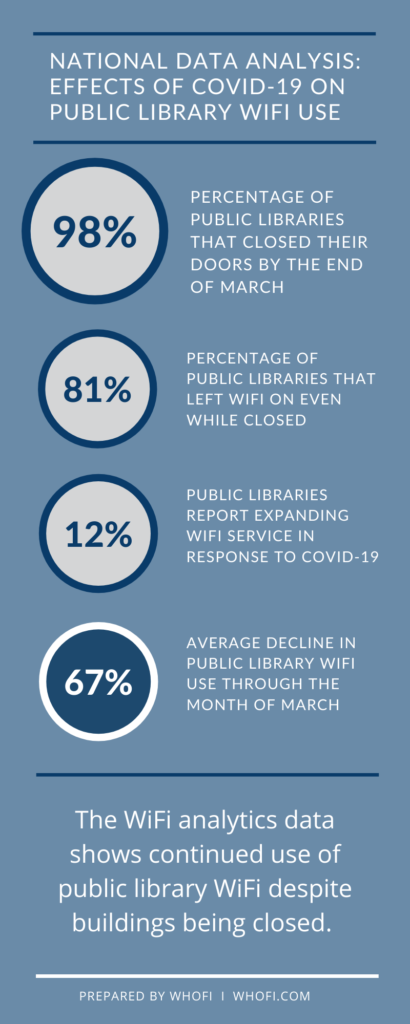
A library closure could be devastating for the individuals and communities that rely on them for all kinds of services. As we well know, libraries do more than check out paper books. Instead of adopting a closed-door, closed services mentality, libraries are quickly adapting. In-person services are created for an online platform, library cards are being issued online, digital learning and check-out programs are being expanded, and free WiFi services continue and grow even more robust. In typical library fashion, they rise to meet the needs of the community they serve quickly, efficiently, and compassionately.
Since mid-March, we’ve heard mutterings and seen stories of libraries adopting the above practices, specifically extending WiFi services. More than simply leaving the WiFi on, libraries are making it easier to access and creating ‘drive-in WiFi’ hotspots to help patrons. If there’s ever a time we need internet access, it’s now. Schools are adopting online learning platforms, many jobs are being done remotely, grocery shopping is done online, and millions of Americans are newly unemployed and need to be able to apply for benefits, find work and seek care. These are all difficult tasks without the internet, perhaps even unsafe in these current conditions.
Libraries can use data to assess patron behavior amid COVID-19 and determine how to best help them.
Our mission is to help community organizations grow by providing accurate insights so they can better serve their community. We consolidated data from our library partners across the U.S. to gain a better understanding of the national response to the COVID-19 outbreak. The following blog posts will outline trends in patron behavior in response to the pandemic and other important factors. If you have questions about your library, please contact our customer support team, and if you'd like to learn more about implementing WiFi analytics at your library, schedule a demo with our team.
1. According to data from the PLA Survey and Response to COVID-19.
2. According to WhoFi data on file for 25 library partners across the U.S.
Library Parking Lots Become WiFi Hotspots In Response To COVID-19 Closures
Drive up, pick a spot and open your laptop. Drive-in WiFi is an emerging trend in response to public spaces closing due to the COVID-19 outbreak. It’s a scene reminiscent of drive-in movies, except people are using WiFi from inside their car, instead of enjoying a film while comfortably seated on the grass.
The outbreak of COVID-19 shuttered businesses and public spaces across the world. While we all stay at home to slow the spread, many of us remain comfortably connected to the internet. Yet 19 million Americans lack access to broadband internet, according to FCC reports. Other reports show 33 million Americans lack access. Either way, that’s a staggering amount. Millions of people don’t have reliable internet access at home and depend on the free WiFi service public libraries provide. In addition to free WiFi, libraries have computers for patron use while at the library and many locations have laptop check-out and WiFi hotspot programs for patrons to use at home. So when the buildings close to the public, that can provide complications for this type of service and outreach.
Doors close but services continue.
Many people rely on the library for services, WiFi included, and closure could be devastating. Schools move to an online learning model, and many jobs are done remotely at home instead of the office. Both of which require a good internet connection. So what are the millions of Americans without access or with limited access left to do?
Libraries are stepping up to meet the community need. According to the PLA response to COVID-19 survey, 98% of libraries closed to the public. But closed doors don’t mean service stops. If anything, libraries are working harder to bring services to the community in a safe way. The survey showed that 81% of libraries leave WiFi on even while the building is closed and 12% expanded or added to their WiFi service in response to the pandemic.
To overcome concerns about patrons complying with social distancing regulations while accessing library WiFi, the staff are getting creative, in typical librarian fashion. Many libraries are installing WiFi hotspots that can be accessed from parking lots or nearby courtyards. These drive-in WiFi access points are helping people attend classes, do work or just stay in touch with family they would otherwise be able to see in person.
In these challenging times, library teams are working hard to continue service to communities.
Locations are extending the reach of the signal by moving routers closer to the window. They’re transforming parking lots into drive-in wifi hot spots using signs and cones to direct users. School buses are being fitted with WiFi routers and parked at apartment complexes and neighborhoods to help children connect to online learning portals. College academic libraries are transforming parking lots into drive-in WiFi hotspots. Public libraries are leaving WiFi on 24/7.
Libraries are key community hubs.
Unemployment claims rose to nearly 17 million in just a few weeks. Public libraries are an important support system for individuals experiencing unemployment. They serve as critical lifelines to people in times of need by providing internet access, loaning technology and providing guidance and help. They are community hubs--offering a myriad of services and support all in one place. In addition to providing free WiFi 24/7, many libraries are extending their laptop loaning programs so people can apply for benefits, a difficult task without access, especially when complying with social distancing rules.
Students need computers to access online classes, and schools and libraries are meeting this need by checking out Chromebooks. Some public libraries already have an electronic check out system in place while others are ramping theirs up. These programs connect patrons to the materials and resources they need to stay afloat during this public health crisis. As we all continue to adjust to this new normal our community libraries will adapt and continue to provide critical resources.
WhoFi Library Edition Makes PLS Reporting Easy
The Public Library Survey report is due in the coming months. Your WhoFi Library Edition makes it simple to report accurate WiFi usage data. The accurate data provides accurate insights into your library's community impact. The Library Edition provides a consistent collecting and reporting standard across state public libraries to better understand how patrons are using their locations. This data provides insights to guide decisions for things like strategic planning, day to day operations, advocacy communications, and programming enhancements. Accurate reporting makes a difference in the impact your library can have in your community. We know that public libraries have always been a community pillar, and continue to provide services when the community needs it most. With the data and insights from your WhoFi dashboard, your library can show accurate numbers to showcase your role in community support.
“The information available through the reports is great. I’m so glad the state purchased this for us. Now the board can see how the library is benefiting the community. We’re really able to show our worth.” Ashton Public Library, Tim Christianson
Here’s what you need to know about reporting WiFi sessions using the WhoFi Library Edition.
Quick Guide:
You will find the total WiFi sessions for the year in cell H24 on the December Monthly Trend Summary. This is the number that should be reported on the PLS.
In-depth Guide:
For detailed and visual instructions, click here.
Happy reporting!
Public Libraries Continue To Serve Communities While Closed to The Public
As of March 17, 2020, the ALA executive board recommends closing public libraries to the public. This message comes as many cities enforce closings for public places to prevent further spread of the COVID-19 virus. This public health crisis further illuminates the digital divide and the need for equal access to information. While our library customers are closing their physical location to protect the health of patrons and the entire community, many are choosing to make WiFi access available 24/7. WhoFi fully supports this and we encourage all of our library partners to establish this as best practice.
Public libraries are doing great work to promote digital inclusion and can continue to do so by maintaining public WiFi service. Libraries are key partners in empowering members of our community to fight the spread of the coronavirus.
You can communicate to your service population that WiFi will still be available through email and social media. We know many patrons either lack access entirely or have limited access, so create signage to place on windows and doors that provide WiFi access information. Work with local governments to get the message to the community. Patrons can access WiFi while remaining in their car at any time of day while being in compliance with the CDC social distancing recommendations. Continue to run your WhoFi analytics software so your library can gather insights into patron WiFi usage during closings. The data gathered during this time will be beneficial for advocacy efforts in the future.
Providing internet connection, especially during a public health crisis, is a critical utility. Equal access to information helps our community as a whole, and in today’s digital age we all depend on it. Yet 19 million Americans lack access to broadband internet, according to FCC reports. Other reports show 33 million Americans lack access. A Pew Research study found that internet access and adoption are tied to demographic variables such as age, education level, household income, and community type. Higher education is tied to increased access and use of the internet. People who live in rural areas are less likely to have internet access than their urban counterparts.
People who use library WiFi as their primary source of internet rely on it for personal and professional reasons including:
- Access or apply for benefits
- Get information from or about local government
- Do schoolwork or research for school
- Access social media
- Get health or medical information
- Look for or apply for a job
- Attend an online class, meeting, or webinar
- Find legal or consumer rights information
- Stay in touch with friends or family
- Read or send email
- Research and buy a product
- Use online banking services or pay bills
- Create or post original media
- Look for answers to computer problems
- Arrange transportation
- Research a new skill
- Learning language (programs or watching videos)
We are committed to serving our public library partners during these uncertain times. We will all be working remotely for the coming weeks, and will still be available by phone or email should you have any questions or needs.
Ideas to help patrons use library free WiFi
- If possible, place the wireless access points closer to the exterior windows to extend the reach of the WiFi signal.
- Make signs to place in windows from the interior of the library with a message about accessing the WiFi network and password.
- Make sings to place in windows with social distancing guidelines while accessing WiFi. These can include:
- Remain in your car while using your device to access WiFi
- Library staff can use tape or chalk to create 'access stations' where patrons can safely stand outside the library while accessing WiFi. New reports show that COVID-19 can travel more than 15 feet in a closed environment with air-conditioning. The CDC guidelines state persons should maintain a 6-foot distance. Make sure your markings allow enough distance between each access station. Post information about the guidelines and purpose of the access station on windows.
Is your library leaving WiFi on? Share your best practices and ideas with us! Email us at support@whofi.com with the subject line: My library is adapting to COVID-19
How Libraries Help Remote Workers
Your public library offers so much value to your community. Everything from children’s programming, language learning, print, audio and digital books, and that’s just the beginning. And what about considering the public library as a workspace for remote workers? Libraries could serve the remote working community by promoting their space as such.
A recent report shows that remote work has surged 400% in the last ten years. Work flexibility is becoming an expectation for the Millennial workforce. According to Forbes, more than one-third of workers in the U.S. are part of the gig economy, which includes freelancers and contractors. Some cities are even using financial incentives to attract remote workers to their communities.
The nature of work is changing.
Tools like online project management systems, virtual meetings, and cloud-based systems make online team collaboration easy and effective. In the absence of the office culture, workers have started to migrate to remote working spaces to combat loneliness and create connections. Whether part of a team or a freelancer, remote workers are making use of co-working spaces for everyday office use and meeting spaces.
Libraries have a unique opportunity to provide even more value to the remote working community by promoting their library as a remote working space.
Co-working spaces are cropping up in cities across the U.S. Libraries could promote their space as a value-added benefit that’s already included in citizens’ taxes. And they already have the amenities remote workers are seeking, such as:
- Free WiFi
- A quiet place to work
- Private meeting rooms for phone or web calls
- Plenty of space to meet as a group
- Office amenities like printers, copiers, scanners, and fax machines
- Clean bathrooms
- Water fountains
- Charging outlets
And, a great atmosphere to focus on work. Libraries are available in any city, which opens up options for remote workers who like to travel. You can even bring your favorite coffee to sip on while you work. Public libraries are well-positioned to help the remote workforce.
Libraries are using WiFi analytics to improve patron experiences and prove the value of public libraries as a co-working space.
WiFi analytics is an easy-to-use technology that works for a single location or multi-location libraries. Our Library Edition allows you to see large scale trends while maintaining user privacy by encrypting their personal information before it even arrives on our cloud system. Librarians can make data-driven decisions using the insights and reports provided through our software.
Libraries can use this software to look for trends that would indicate patrons are using their space for work, like staying logged on for multiple hours at a time. Seeing these trends on your WiFi analytics dashboard could help you develop services, equipment, or programs geared toward this group. Offering freelancing programs or seminars with business speakers, presentation equipment rental, or more private conference rooms can help make your library a great place to work remotely.
The rise in remote work certainly offers many benefits and the flexibility the modern workforce expects. In the absence of office culture, co-working spaces are becoming more popular. This workplace trend appears to be a mainstay, and public libraries can promote themselves as an option for remote working spaces. Learn how WiFi analytics help you serve the remote workers in your community. Schedule a demo today.
WiFi analytics relieves the burden of data tracking for public libraries
Public libraries provide a safe space for communities to come together. They serve communities in urban, suburban, and rural neighborhoods. They provide cultural and economic value. And now, many libraries are becoming community hubs. Libraries and public spaces can use WiFi analytics to help tell their story, reinforce their value, and better serve their community.
Using WiFi analytics is the best way to harness technology to build strong communities, and it’s easier to do than you may think.
There is no barrier to entry.
From your initial demo all the way through your partnership with us, your WhoFi team will guide you every step of the way. Starting a new program or integrating new technology may feel like a barrier toward reaching your goals.
We know that getting over this barrier is a deterrent, which is why we removed the barrier completely.
The WhoFi software works with the technology you already have which makes it easy to integrate into your current public library WiFi system. What’s even better is that it can be installed by just about anyone-no IT background required.
You can start now.
Learn more
If you’re curious to learn more about how our WiFi analytics software works and get answers to your questions, the first step is to schedule a demo. You'll get an in-depth look at what WiFi analytics can do for your space.
Get connected
Once you decide to partner with us, your customer advocate will reach out to schedule a meeting to get acquainted and review the next steps with you. Our set up process is refreshingly simple, and your customer advocate will lead you through each step.
How does set up work?
Since you can use our WiFi analytics service with the hardware you already have, the set-up process is simple. We’ll discuss this easy process with you on a set-up call and send written instructions for easy reference. If you need extra help we’ll be here to troubleshoot with you.
All setup and ready to go
When you activate your account the software will collect data and store it in your user account. Your customer advocate will familiarize you with the dashboard and provide login details. You can access your account and view your dashboard at any time, which makes it easy to grab data when you need it, without waiting for reports to be sent to you.
Sit back, relax and gather insights (while respecting user privacy, of course)
Our customers really appreciate how easy the whole process is. The initial set up process is straightforward and easy with minimal hands-on time. Our software quietly works in the background, collecting insights, while you focus on improving the lives of those you serve.
Benefits of using WhoFi analytics
Dedicated customer advocates
Every WhoFi user has a customer advocate who answers questions, troubleshoots problems or interprets reports and makes suggestions. When you call or email us for support, you’ll reach one of our customer advocates who are knowledgeable and skilled in technology and customer service. Having a dedicated support person helps with ease of implementation and management for any technology or service. No call centers with rotating staff, no inexperienced service members, just a real person who knows the technology in and out and solves problems like a pro.
Your customer service advocate will schedule followup training calls to discuss and review your data in-depth. We’ll also send you your statistics monthly along with helpful training material. We monitor your activity and notify you asap if there’s an issue so we can troubleshoot it.
Easy Data Reporting
Each user views all aggregated data in an easy to read dashboard. The dashboards provide easy to understand insights without technical jargon. You can compare date ranges, see trends, see increases or decreases in visitors by various date ranges and so much more.
The reports convert the data collected into insights so you can decide how best to improve your community space.
One of the reports available is called Average Usage that shows the most popular times patrons use the public libraries' WiFi. This kind of report helps each location plan staffing, program types and timing, ideal network maintenance and more. Being able to see how many people access WiFi, at what times and for how long allows each space to ensure there are enough staff and bandwidth to accommodate that need. The reports give accurate insight into the use of public libraries' WiFi. This helps boards make data-driven decisions to invest in better WiFi or extended programming.
We respect user privacy and we’ll keep you in compliance with the CCPA.
Looking at data on a massive scale is what gives spaces the best insight into visitor behaviors and patterns. WhoFi allows you to see large scale trends while maintaining visitor privacy by using a one-way encryption method. Every time someone uses your public libraries' WiFi, the reports will show their frequency of use and how long they stayed, but maintain user privacy. Being able to see big-picture trends while maintaining patron privacy has been a game-changer for libraries.
WhoFi is pioneering the big data privacy movement with our anonymous location analytics technology that allows companies to see trends while maintaining consumer trust and privacy. Our analytics solution provides a detailed analysis of physical spaces and foot traffic. This insight means businesses can make data-driven decisions while maintaining customer anonymity.
Your partner in building strong communities
Creating strong communities takes a community effort. WhoFi helps public spaces like libraries share the story of their community value. We know the services provided have a strong community impact and enhance the quality of life for all citizens. With our easy to use WiFi analytics software, public spaces can use data to support continual growth and improvements. Are you ready to learn more about how WiFi analytics can help your library or public space? Schedule a demo.
Using WiFi Analytics To Improve Patron Experiences
The best way to improve your space for your patrons is to analyze the actions of those who frequent your space. Actions speak louder than words, and in the case of creating a thriving public venue, this is absolutely true. People will let you know if you’re meeting their needs by showing up, or not. Make sure your space is answering the call. Use WiFi analytics to understand what your patrons want so you can improve their experience and your space.
WiFi analytics is an easy-to-use technology that works for any type of space large or small, public or private. If you want to know more about the people coming to your space, WiFi analytics provides the answers you seek while being non-intrusive and respecting privacy. After a simple software download, your system will be ready to gather a wealth of information you can use to determine the best path forward.
Easy Data Reporting.
Our Library Edition allows you to see large scale trends while maintaining the privacy of each individual by using a one-way encryption method. Each time the visitor accesses your WiFi the reports will show their frequency of use, dwell time and patterns, but not the individual identity of the user. Being able to see big-picture trends while maintaining patron privacy has been a game-changer for libraries.
One of the reports available as a WhoFi user is called Average Usage, which was designed to provide public libraries a quick view of the most popular times patrons are connecting to their locations’ WiFi. This kind of report helps each location plan staffing, program types and timing, ideal network maintenance and more. Being able to see how many people access WiFi, at what times and for how long allows each space to ensure there’s enough bandwidth to accommodate that need. The reports give accurate insight into the use of public WiFi and help boards make data-driven decisions to invest in better WiFi or extended programming.
Interpreting Data, Making Change.
Are you noticing that some users access WiFi with a laptop and stay logged in for 3-5 hours at a time? This could indicate that they’re using the space as a place to work. Remote work is becoming more common and people like to get out of the house and into coffee shops, libraries or other public spaces to change the scenery, spur creativity, or just connect with other like-minded individuals. Seeing this trend on your WiFi analytics dashboard could help you develop services, equipment, or programs geared toward this group. Offering freelancing programs or seminars with business speakers, presentation equipment rental, or more private conference rooms can help make your library a great place to work remotely.
If you’re a multi-location business or library, using the Trend Summary report can help you compare locations to get a birds-eye view of the trends affecting your space. Gain insights into peak days and hours, new vs. return visitors, visitor dwell time and even popular areas inside larger spaces. This gives you the confidence to make decisions about how your space is used, could or should be used, appropriate staffing needs, marketing improvements, and resource planning.
Your patrons will notice that you’re attuned to their needs and they’ll show you their gratitude by continuing to visit. Small changes like improved staff during peak hours can mean prompt service, questions answered sooner, program materials restocked or spaces kept tidy. These details all contribute to the overall experience that your patrons want.
With WiFi analytics, it’s possible to listen to, understand and see more about the people who visit your location without constantly hammering them for personal information and data.
When you know more about the people visiting your space and how they interact with you, you can better serve them. Then, when you meet their needs, word of mouth will spread that your space is good and you will continue to grow.
Want to know more about how WiFi analytics can benefit your location? Schedule a demo and we’ll show you!

